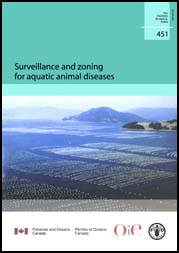 |
FAO FISHERIES TECHNICAL PAPER 451
|
Surveillance and zoning
for aquatic animal diseases
Cover photograph:
Courtesy of DongLim Choi, National Fisheries Research and Development
Institute, Pusan, Republic of Korea
edited by
Rohana P. Subasinghe
Inland Water Resources and Aquaculture Service
Fishery Resources Division
FAO Fisheries Department
Sharon E. McGladdery
Department of Fisheries and Oceans Canada
Oceans and Aquaculture Science
Ottawa
Canada
and
Barry J. Hill
Centre for Environment, Fisheries and Aquaculture Science
Weymouth Laboratory
The Nothe, Weymouth
United Kingdom
|
|
FOOD AND AGRICULTURE ORGANIZATION OF THE UNITED NATIONS
Rome, 2004
|
| |
Table of Contents
|
The designations employed and the presentation of material in this information
product do not imply the expression of any opinion whatsoever on the part of the
Food and Agriculture Organization of the United Nations or of the Department of
Fisheries and Oceans Canada or of the World Organisation for Animal Health concerning
the legal or development status of any country, territory, city or area or of
its authorities, or concerning the delimitation of its frontiers or boundaries.
ISSN 0429-9345
ISBN 92-5-105116-X
All rights reserved. Reproduction and dissemination of
material in this information product for educational or other non-commercial
purposes are authorized without any prior written permission from the copyright
holder provided that source is fully acknowledged. Reproduction of material in
this information product for resale or other commercial purposes is prohibited
without written permission of the copyright holders.
Application of such permission should be addressed
to:
Chief
Publishing Management Service
Information Division
FAO
Viale delle Terme di Caracalla, 00100 Rome, Italy
or by e-mail to:
[email protected]
© FAO 2004
TABLE OF CONTENTS
PREPARATION OF THIS
DOCUMENT
ABSTRACT
FROM THE
EDITORS
LIST OF ABBREVIATIONS AND
ACRONYMS
RELEVANT DEFINITIONS FROM THE OIE
AQUATIC ANIMAL HEALTH
CODE
ADDITIONAL DEFINITIONS RELEVANT TO
NATIONAL SURVEILLANCE PROGRAMMES
EXECUTIVE
SUMMARY
INTRODUCTION
GUIDING
PRINCIPLES
SCIENTIFIC PRINCIPLES FOR
SURVEILLANCE TO ESTABLISH AND MAINTAIN ZONES
Animals in general
Finfish
Crustaceans
Molluscs
OVERVIEW OF SURVEILLANCE AND
ZONING
What is disease
surveillance?
Importance of disease
surveillance
Purpose and objectives of
surveillance
Types of surveillance
What is zoning and what are
zones?
Importance of zoning
How are zone boundaries
defined?
Types of zones
Zones free of specific
diseases
Buffer zones for specific
diseases
Movement of animals between
zones
Relationship of surveillance and
zoning to import risk analysis
GUIDELINES FOR SURVEILLANCE AND
ZONING
Diagnosing disease
Establishing a case
definition
Investigating disease
outbreaks
Disease outbreak
investigation
DISEASE
SURVEILLANCE
Basic requirements for implementing a
surveillance programme
Clearly stated
objectives
List of diseases
Capability and capacity
Information
specifications
Data management and
reporting
Transparency and disease
reporting
Implementing a basic surveillance
programme
Surveillance to support
zoning
Surveillance questions
SURVEILLANCE AND ZONATION - A
PRACTICAL CASE STUDY
Atlantic Canadian oyster disease
surveillance
REFERENCES
APPENDIXES
Appendix I. A model plan for
strengthening national and regional capabilities in disease
surveillance
Appendix II. List of participants of
the Expert Consultation
Appendix III. Consultation work
programme
BACK COVER
